#aem dispatcher caching cache
Explore tagged Tumblr posts
Text
A Comprehensive Guide to Adobe Experience Manager (AEM) Development - Technology Org
New Post has been published on https://thedigitalinsider.com/a-comprehensive-guide-to-adobe-experience-manager-aem-development-technology-org/
A Comprehensive Guide to Adobe Experience Manager (AEM) Development - Technology Org
Adobe Experience Manager (AEM) is a comprehensive content management solution for building websites, mobile apps, and forms. AEM makes it easy to manage your marketing content and assets, and as a developer, understanding the intricacies of AEM development is crucial for creating dynamic, personalized experiences. This guide will walk you through the key components of AEM development, as outlined in our knowledge graph.
Laptop, smartphone – illustrative photo. Image credit: rupixen via Pixabay, free license
Understanding AEM
AEM Overview
AEM is a powerhouse when it comes to digital experience management, offering features like web content management, digital asset management, and multi-channel publishing. With the advent of AEM as a Cloud Service, developers now have access to a more scalable, secure, and agile environment.
AEM Architecture
The architecture of AEM is foundational to grasping its capabilities:
Repository (CRX): At its heart lies the Java Content Repository (JCR), implemented in AEM through Apache Jackrabbit Oak, which provides a hierarchical content structure, much like a filesystem.
OSGi Framework: Modularizes the Java classes into bundles, promoting dynamic component and service management.
Sling Framework: Adheres to RESTful principles, managing the routing of requests to the appropriate resource or component.
Dispatcher: Acts as AEM’s caching and/or load balancing tool, ensuring optimal performance and security.
Development Toolkit
Development Tools
AEM offers several tools for development, such as:
AEM Developer Tools for Eclipse: Allows for seamless integration with AEM instances directly from the Eclipse IDE.
CRXDE Lite: A lightweight, web-based IDE provided within AEM for quick edits and explorations.
Apache Maven: A build automation tool used for managing project dependencies and builds.
Building the Experience
Frontend Development
Frontend development in AEM involves:
HTL (HTML Template Language): Secure and efficient templating system to render the markup that AEM serves to the client.
ClientLibs: Manages JavaScript and CSS assets, allowing you to encapsulate and optimize front-end code.
Backend Development
The server-side of AEM is where Java takes center stage:
Java APIs: AEM provides a rich set of Java APIs for building robust backend logic.
Servlets: Allow for handling of requests and responses within AEM.
OSGi Services: Custom Java classes that can be deployed as services in AEM.
Component and Template Development
Components are reusable modules that form the building blocks of an AEM page, while templates define the structure:
Component Basics: The foundation of any AEM page, including the logic and presentation.
Dialogs and Widgets: Define the editable properties of components.
Editable Templates: Allow marketers to create and manage page structures with predefined layouts.
Advanced Features
Workflow Management
To automate content management processes, AEM offers workflows:
Workflow Models: Define the steps and actions of a business process.
Workflow APIs: Allow developers to interact with and extend workflow capabilities.
Content Services
AEM’s headless capabilities are facilitated by:
Content APIs: Enable the delivery of content to any channel.
Content Fragments: Reusable, presentation-agnostic content.
Experience Fragments: Reusable content and layout for consistent experiences across channels.
Enhanced Personalization and Targeting in Adobe Experience Manager Development
In the realm of Adobe Experience Manager Development, personalization and targeting are pivotal aspects that drive customer engagement and conversion. AEM provides a rich set of tools to create personalized experiences tailored to individual user needs and preferences. This section will delve deeper into the methodologies and tools available within AEM to craft these bespoke experiences.
Contextual Personalization with ContextHub
ContextHub is AEM’s data handling framework designed to capture, store, and manage user context data. It plays a critical role in personalization by enabling developers to:
Capture rich behavioral and environmental data about site visitors, such as location, device, browser, and session activity.
Create a unified view of each visitor’s context by consolidating data from various sources.
Utilize the data to tailor the user experience in real-time, providing content that resonates with the user’s current needs and interests.
ContextHub lays the foundation for developers in Adobe Experience Manager Development to build experiences that adapt dynamically to the user’s context.
Audience Segmentation for Targeted Content
Audience segmentation is a powerful feature in AEM that allows for the grouping of users based on shared characteristics. This capability enables developers to:
Define criteria for segmenting users into distinct groups, such as demographic data, behavior patterns, or customer lifecycle stages.
Leverage AEM’s segmentation feature to dynamically display content that is most relevant to each group.
Continuously refine segments based on user interactions and engagement metrics to improve the accuracy and effectiveness of personalization efforts.
Effective segmentation ensures that each user group receives content and offers that are specifically designed to appeal to their interests and motivations.
Leveraging Campaign Management for Personalization
Adobe Experience Manager Development seamlessly integrates with Adobe Campaign, affording developers the ability to:
Synchronize content and messaging across various marketing channels, ensuring a consistent and personalized user journey.
Utilize AEM’s capabilities to create campaign content that can be repurposed across web, email, and mobile platforms, maintaining brand consistency and relevance.
Track campaign performance directly within AEM, allowing for quick adjustments based on real-time analytics and insights.
The integration of campaign management with AEM’s content management features empowers organizations to deliver personalized marketing campaigns efficiently and effectively.
Personalization through Experience Fragments
Experience Fragments in AEM are modular and reusable components that encapsulate design, content, and logic. They are instrumental in personalization, enabling developers to:
Design and deploy reusable content blocks that provide consistent experiences across different channels and touchpoints.
Combine various Experience Fragments to assemble pages that cater to specific user segments or personas.
Quickly test and iterate on different variations of content and layouts to determine the most effective combinations for engagement and conversion.
Experience Fragments are a cornerstone in Adobe Experience Manager Development, providing the flexibility needed to rapidly adapt to changing user expectations and market trends.
Personalized Search Experiences
Search functionality within AEM can be personalized to enhance user experience. Developers can:
Customize search algorithms to prioritize results based on user data and behavior.
Implement machine learning and artificial intelligence capabilities from Adobe Sensei to refine search results and recommendations over time.
Apply AEM’s tagging and taxonomy features to align search results with the user’s context and previous interactions.
A personalized search experience ensures users find the content they are looking for quickly and efficiently, which can significantly improve their overall experience.
Continuous Improvement with A/B Testing and Analytics
Lastly, the cycle of personalization in Adobe Experience Manager Development is incomplete without the tools for testing and analytics:
Utilize A/B testing to compare different versions of personalized content and determine which performs better in terms of user engagement and conversion rates.
Integrate with Adobe Analytics to gather detailed insights into user behavior, content performance, and the effectiveness of personalization strategies.
Employ the insights gained to make informed decisions about content updates, user experience improvements, and to refine personalization algorithms.
Adobe Experience Manager provides a robust environment for developers to create highly personalized user experiences. Through the use of ContextHub, audience segmentation, integrated campaign management, Experience Fragments, personalized search, and continuous improvement through testing and analytics, Adobe Experience Manager Development stands as a beacon for creating targeted and meaningful digital experiences that resonate with users on an individual level.
Testing, Security, and Performance
Testing and Deployment
A robust testing framework ensures reliability:
Unit Testing: Ensures individual code components work correctly.
Integration Testing: Tests the interactions between AEM components.
CI/CD Pipelines: Streamlines the process of code integration and deployment.
Security
Security is paramount, and AEM addresses it through:
User and Group Management: Controls access with fine-grained permissions.
Access Control Lists (ACLs): Further refines what users can do in AEM.
SSO Integration: Simplifies the login process by integrating with enterprise single sign-on systems.
Performance and Optimization
To ensure AEM’s high performance, consider:
Dispatcher Configuration: Optimizes caching strategies and security.
Query Performance: Writing efficient queries to avoid performance bottlenecks.
Asset Optimization: Ensures media assets are delivered effectively.
Maintenance and Best Practices in AEM Development
Maintaining an Adobe Experience Manager (AEM) instance and adhering to best practices are critical to ensure that the platform remains reliable, secure, and performs at its best. Below are detailed insights into the activities and guidelines that should be incorporated into your AEM development and maintenance routine.
Maintenance and Operations
System Monitoring
Continuous monitoring is essential for preempting issues before they impact users. Tools like Adobe’s Managed Services or third-party monitoring solutions can be used to keep an eye on:
System Health: CPU usage, memory usage, disk space, and network I/O.
Application Health: AEM instance statuses, bundle states, and component health.
Performance Metrics: Response times, slow requests, and error rates.
Regular audits of the logs and error reports should be scheduled to detect anomalies that might indicate underlying issues.
Backup and Restore
A robust backup strategy ensures that you can quickly recover from hardware failures, data corruption, or other disasters:
Data Backup: Regular and systematic backups of the repository, workflows, and configurations.
Consistency Checks: Regular integrity checks of the repository.
Restore Procedures: Documented and regularly tested restore procedures to ensure minimal downtime in case of system failure.
Upgrades and Versioning
Upgrading AEM to the latest version allows you to take advantage of new features, security patches, and performance improvements:
Upgrade Testing: Test upgrades in a staging environment to identify any potential issues before they affect the production system.
Rollback Plan: Always have a rollback plan in case the upgrade encounters unexpected issues.
Version Control: Use a version control system for your codebase to track changes, manage code history, and facilitate team collaboration.
Best Practices
Coding Standards
Following coding standards is crucial for maintaining code quality and ensuring that the codebase is understandable and maintainable by all team members:
Code Reviews: Implement a peer review process to ensure code quality and adherence to standards.
Documentation: Document the code and its purpose, as well as any important architectural decisions.
Code Analysis Tools: Integrate static code analysis tools in your development process to automatically enforce coding standards.
Performance Guidelines
Performance directly affects user experience, so it’s vital to optimize both the frontend and backend:
Efficient Resource Handling: Implement lazy loading for resources, optimize images, and minify JavaScript and CSS.
Caching Strategies: Utilize AEM’s Dispatcher cache effectively and define proper caching headers for client-side caching.
Query Optimization: Optimize queries to reduce load on the repository and avoid performance bottlenecks.
Security Recommendations
Securing an AEM platform is an ongoing process that involves multiple layers of protection:
Regular Security Audits: Conduct security audits to identify and fix vulnerabilities.
Principle of Least Privilege: Ensure that users have the minimum level of access required to perform their tasks.
Secure Development Lifecycle: Integrate security practices throughout the development lifecycle, from design to deployment.
Patches and Updates: Keep AEM and all its components up to date with the latest security patches.
Conclusion
In summary, maintaining an AEM instance requires diligent monitoring, regular backups, and careful planning for upgrades. Best practices in coding, performance optimization, and security are not just guidelines but essential standards that need to be incorporated into the development lifecycle. By adhering to these practices, you can ensure a robust, efficient, and secure AEM environment that stands the test of time and evolves with the needs of the business.
#adobe#agile#Algorithms#Analysis#Analytics#Apache#APIs#apps#architecture#artificial#Artificial Intelligence#assets#automation#backend development#backup#backups#Behavior#browser#Build Automation#Building#bundle#Business#cache#Capture#channel#CI/CD#classes#Cloud#cloud service#code
1 note
·
View note
Link
An AEM author can also flush the dispatcher caching from the AEM interface. Check this wonderful feature of ACS-commons.
0 notes
Text
Amazon Web Service & Adobe Experience Manager:- A Journey together (Part-2)
In the fist part we discussed how one day digital market leader meet with the a friend AWS in the Cloud and become very popular pair. Also what gift they bring for the digital marketing persons.
Now AEM asked to come to my home.
So AEM insides about its parts and structure explored.
AEM Platform :
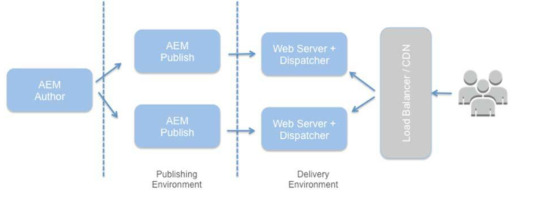
AUTHOR:-
The content and layout of an AEM experience are created and managed in the author environment. It offers features for authoring content modifications, reviewing them, and publishing the approved versions of the content to the publish environment.
PUBLISH:-
The audience receives the experience from publishing environment. With the option to customize the experience based on demographics or targeted messaging, it renders the actual pages.
Both AUTHOR and PUBLISH instances are Java web applications that have identical installed software. They are differentiated by configuration only.
DISPATCHER:-
Dispatcher environment is the responsible for caching (storing) content and Load balancing.Helps realize a fast & dynamic web authoring environment.
Mainly dispatcher works as part of HTTP server like Apache HTTP. It store as much as possible static content according to specified rules.
So end user feel faster accessing of content and reducing load of PUBLISH. The dispatcher places the cached documents in the document root of the web server.
How AEM Store Content in Repository:-
AEM is storing data without any discrimination as it treated all the family member (data) are content only . Its following philosophy of "everything is content" and stored in the same house(Repository).
Its called CRX i.e. implementation of JCR coming from parent Content Repository API for Java and Apache Jackrabbit Oak.
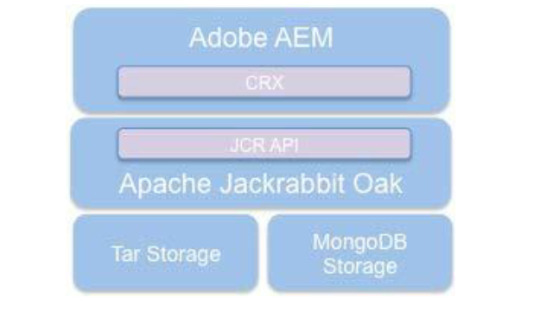
The basement(base) of the building is driven by MK MicroKernels as in the picture its Tar or MongoDB. The Oak storage layer provides an abstraction layer for the actual storage of the content. MK act as driver or persistence layer here. two way of storing content , TAR MK and MongoDB MK.
TAR--> tar files-->segments
The Tar storage uses tar files. It stores the content as various types of records within larger segments. Journals are used to track the latest state of the repository.
MongoDB-->MongoDB database-->node
MongoDB storage leverages its sharding and clustering feature. The repository tree is stored in one MongoDB database where each node is a separate document.
Tar MicroKernel (TarMK)--for-->Performance
MongoDB--for-->scalability
For Publish instances, its always recommended to go with TarMK.
In more than one Publish instance each running on its own Tar MK then this combination is called TarMK Farm. This is the default deployment for publish environments.
Author instance is having freedom to go with either TAR or MongoDB. it depends on the requirement, if its performance oriented and limited number then it can go with the TarMK but if it require more scalable instances then it would go with the MongoDB. TarMK for a single author instance or MongoDB when horizontal scaling.
Now story of TarMK with Author, a cold standby TarMK instance can be configured in another availability zone to provide backup as fail-over.
TarMK is the default persistence system in AEM for both instances, but it can go with different persistent manger (MongoDB).
Gift of TarMK:-performance-optimized,for typical JCR use cases and is very fast, uses an industry-standard data format, can quickly and easily backed up, high performance and reliable data storage, minimal operational overhead and lower total cost of ownership (TCO).
Now story of MongoDB it basically come into picture when more hands required, means more user/author (more than
1,000 users/day, 100 concurrent users)and high volumes of page edits required. To accommodate these horizontal scalability required and solution is with MongoDB. It leverage MongoDB features like high availability, redundancy and automated fail-overs.
MongoDB MK can give lower performance in some scenario as its establish external connection with MongoDB.
A minimum deployment with MongoDB typically involves a
MongoDB replica consisting of
1)one primary node
2)two secondary nodes,
with each node running in its separate availability zone.
AEM--store--binary data--into ---data store.
AEM--store--content data--into ---node store.
And both stored independently.
Amazon Simple Storage Service (Amazon S3) is best high performant option for shared datastore between publish and author instances to store binary files(Assets like image etc).
Continue....
3 notes
·
View notes
Text
AEM Dispatcher
What is AEM Dispatcher?
Get In Touch
AEM Dispatcher is a web server module (provided by Adobe) that sits in front of an AEM instance and caches and delivers content to users. It acts as a proxy server that intercepts requests to AEM and serves cached content whenever possible. AEM Dispatcher can be used to cache both static and dynamic content, and it uses a set of rules and configurations to determine when to serve cached content and when to forward requests to AEM.
Key benefits of using AEM Dispatcher:
Improved performance: AEM Dispatcher reduces the load on the AEM instance by caching and serving content from the cache.
Reduced server load: By serving content from the cache, AEM Dispatcher reduces the load on the AEM server, allowing it to handle more requests and users.
Better security: AEM Dispatcher can be configured to provide an additional layer of security for AEM by blocking harmful requests and limiting access to certain resources.
Scalability: AEM Dispatcher can be used to distribute content across multiple servers, making it easier to scale AEM for large-scale deployments.
How AEM Dispatcher works:
AEM Dispatcher works by intercepting requests to AEM and checking whether the requested content is in the cache. If the content is in the cache, AEM Dispatcher serves it directly to the user.
If the content is not in the cache, AEM Dispatcher forwards the request to AEM, which generates the content and sends it back to AEM Dispatcher.
AEM Dispatcher then caches the content and serves it to the user. AEM Dispatcher uses a set of rules and configurations to determine when to serve cached content and when to forward requests to AEM.
Dispatcher setup for AEM as a cloud service in linux/mac using docker
Prerequisites for Dispatcher Setup
Apache 2.2 web server
Dispatcher Module
Docker setup in local
Installation Instructions
Install Apache web server
Run this command to install the apache package on ubuntu
sudo apt install apache2 -y
Install Docker
Run this command to install the latest docker package on ubuntu
sudo apt-get install docker-ce docker-ce-cli containerd.io docker-buildx-plugin docker-compose-plugin
For Verify docker was installed correctly, Run this comman
docker --version
Execute
aem-sdk-dispatcher-tools-<version>-unix.sh
Run this command to execute script
chmod +x <fileName>
sudo ./<fileName>
Validate the Dispatcher configuration contained in this SDK
$ sudo ./bin/validator full -d out src
This validates the configuration and generates deployment information in out
Validate the deployment information by the Dispatcher in a docker image
$ sudo ./bin/docker_run.sh out localhost:4503 test
This will start the container, run Apache in configuration test mode (httpd -t), dump processed dispatcher. any config (-D DUMP_ANY) and exit.
Confirm that no immutable config file was changed against a docker image ones
$ sudo ./bin/docker_immutability_check.sh src
With your AEM publish server running on your computer, listening on port 4503, you can start the dispatcher in front of that server as follows:
$ sudo ./bin/docker_run.sh out host.docker.internal:4503 8888
Sometimes, You may encounter this error “Waiting until host.docker.internal is available”, to resolve this use your host ip
bin/docker_run.sh src <HOST IP>:4503 8888
Read more!!
0 notes
Text
Optimize author experience and author performance in AEM
Optimize author experience and author performance in AEM
Problem statement: How to improve the authoring experience in AEM using SDI? Can I optimize page load time? Can I cache all experience fragments on the pages in AEM? Introduction: The purpose of the module presented here is to replace dynamically generated components (eg. current time or foreign exchange rates) with server-side include tags (eg. SSI or ESI). Therefore, the dispatcher is able…

View On WordPress
0 notes
Text
AEM Developer Exam AD0-E116 Real Questions
If you want to clear AD0-E116 Adobe Experience Manager Sites Developer Expert exam on the first attempt, then you should always focus on your preparation level. PassQuestion AEM Developer Exam AD0-E116 Real Questions are one of the best tools that you can use for the preparation of the Adobe AD0-E116 exam. It will help you clear all concepts and you will have to go through our AEM Developer Exam AD0-E116 Real Questions multiple times to ensure your success in the exam. Our AEM Developer Exam AD0-E116 Real Questions include multiple products including PDF files, practice exam. You will be able to get complete technical assistance and guidelines for the preparation of Adobe AD0-E116 exam so you can pass your exam on the first attempt.
Adobe Experience Manager Sites Developer Expert
Adobe Certified Expert - Adobe Experience Manager Sites Developer certification is the industry-recognized validation of one's proficiency in, and successful implementation of Adobe Experience Manager Developer. It demonstrates to the marketplace that you're able to perform a job role using Adobe's leading solutions. Get recognized for your expertise with Adobe products and differentiate yourself from the crowd.
Exam Information
Exam number: AD0-E116
Exam name: Adobe Experience Manager Developer
Certificate level: Certified Expert
Status: Active
Available languages: English
Number of questions: 50
Formats: Multiple choice and multiple select
Duration: 100 minutes
Delivery: Online proctored (requires camera access) or test center proctored
Passing mark: 64% or 32/50
Price: $225 USD / $150 USD (India)
NOTE: This exam covers AEM 6.4, 6.5, and AEM as a Cloud Service.
Exam Objectives and ScopeSection 1: Configurations (22%)
Identify the steps to create and manage AEM dispatcher configurations
Determine the correct steps to configure multi-tenancy
Explain how to create and manage OSGi configurations
Given a scenario, determine the correct method to Create and manage custom OAK indices
Determine the correct steps to configure OOTB SAML and LDAP integration
Section 2: AEM Development (46%)
Determine the correct steps to implement SPA structure and components
Given a design, create complex components including the HTL, models, and services
Determine the correct method to create unit tests and map mock data
Given a scenario, determine the correct method to develop workflows
Given a scenario, determine the approach for any third-party integration
Determine the approach to implement a headless or hybrid implementation
Section 3: Build and Deployment (8%)
Identify the steps to set up and maintain front-end and back-end dependency management
Determine the correct usage of each archetype when building projects
Section 4: Environment Maintenance (24%)
Given a scenario, determine the steps required to manage AEM environments
Explain the setup steps around release management
Recommend & implement solutions to sync content/configurations across AEM environments
Determine the steps required around planning and implementing AEM upgrades and repository migration activities/tasks
View Online Adobe Experience Manager Sites Developer Expert AD0-E116 Free Questions
There are performance, stability, and security issues with an installed AEM instance. What should a developer do to fix these issues? A.Delete and reinstall the AEM instance. B.Install Adobe-provided Apache configuration file. C.Stop, clear cache files, and restart the AEM instance. D.Install service pack updates from package share. Answer: D
What is the artifact ID of the maven dependency that contains all core AEM APIs? A.core-jar B.api-jar C.aem-jar D.uber-jar Answer: D
A developer installs the latest Service pack to a local AEM author instance. How should the developer install this package on the publish instance? A.Replicate from package manager of publish instance B.Use upload/install from OSGi console of publish instance C.Replicate from package manager of author instance D.Use upload/install from OSGi console of author instance Answer: C
A developer is working on a project locally and needs to install packages manually. The deployments to the localhost must be automated to speed up development. This functionality must be toggled on and off, depending on the needs of the developer. Which step should the developer take to achieve this? A.Configure the maven install plugin by defining the target URL, username and password as maven properties. B.Add a maven profile and configure the content package maven plugin within this profile C.Write a script that does a PUT call to AEM each time maven builds a new package D.Run maven with the deploy phase. Maven will install the package on all local AEM instances running without further configuration Answer: B
A custom AEM application is using the PageManager API. What should a developer add to make the application compile and run correctly in AEM? A.a maven dependency to AEM uber-jar to the content package B.a maven dependency tobundle cq-wcm-core to the application bundle C.a maven dependency to AEM uber-jar to the application bundle D.a maven dependency to bundle cq-wcm-api to the content package Answer: C
0 notes
Text
AEM - Automation -- Package Deployment
AEM – Automation — Package Deployment
SYNOPSIS:
Following is the guide to Download, Install, Replicate AEM Package and Flush the Dispatcher Cache. The Job can be achieved in several different ways, and there is always room for improvement. In this tutorial we shall download the package from lower environments and install the downloaded package to a different environment.
This Tutorial is an advancement to the following blog AEM…
View On WordPress
#AEM#AEM ACS Commons#aem acs commons dispatcher flush#AEM Automation#AEM Deploy#aem deploy package using curl#AEM Dispatcher Flush#AEM Jenkins#aem package management#AEM replicate package using cURL#AEM Replication#AEM Replication using cURL#AEM Windows#AEM6.3#AEM6.4#Windows Server
0 notes
Text
AEM Online Training With Placement Assistance From SV Tech Hub
AEM Course Overview:
Adobe Experience Manager (AEM) is a content management solution for building websites. This system will make it easy for professionals to manage marketing content and assets and then deliver them to right person at right time. Through AEM customers will experience a user friendly interfaces and built in features. Through AEM one can create web pages by using drag and drop options.

SV Tech Hub provides Online AEM Training with 7+ years of real time expert, real time project and Demo classes online.
About SV Tech Hub:
SV Tech Hub is leading training institute from India with a good placement assistance record. We are supported by industry certified trainers. We will provide online training with job assistance. We provide training on almost all software technologies with the help of MNC working professionals as trainers. Our experienced and highly skilled trainers will guide you with real time use cases and they also help you in resume preparation.
Our AEM Training Features Includes:
Online training by certified trainers
Training with real time scenarios
24/7 access to AEM Course
Detailed course material
Online doubt clarification
What We Offer You?
Experienced faculty from all parts of world who have strong industrial working experience with MNC companies for several years. Our support team will always assist you with resume guidance, interview question and answer sessions, mock interviews etc.
AEM Online Training Course Content:
Course Content - AEM 6.4
Basic: (15 Hours)
Lab 1:
Overview of AEM.
Installation of Author and Publish Instances.
Technology Stack of AEM – Overview.
AEM Consoles Walkthrough – DAM/CRXDE/TOOLS etc.
Lab 2:
Modes of AEM - Classic UI vs Touch UI.
AEM Basic Component development through CRX/DE – Classic UI.
Authoring Basics – WCM Modes.
Dialog Creation – Side Kick Overview, Parsys.
Template Creation and properties definition.
Sample Page creation in Classic UI.
Lab 3:
Sling Framework in depth.
Resource Resolution via different files. (Selector, extension etc.)
Working demo on Sling Resource Resolution.
Lab 4:
Continue Lab 2 for Classic UI:
Enhance component with editConfig.
I-parsys.
Design dialog.
Listeners in dialog.
X-Type –Multi field, Checkbox, Radio Button in dialog.
Lab 5:
Integrating client library to AEM Components.
Handshaking between AEM + FED (Front End dev)
Client Library magnification.
Different Layouts in AEM – Demo.
Sample Banner Component with Text and Image.
Lab 6:
Packaging content – Package Manager
Activation – Page, Code and Activate Tree.
Replication Agents configuration.
Publish Instance Setup.
Lab 7:
Client library options: Embed, dependencies with demo.
Create a component – Accordion using multi field.
jQuery integration in AEM – Different Ways.
Lab 8:
Touch UI – Consoles Demo.
Migration of Lab-4, Component into Touch UI.
Different type of resource Type in Touch UI dialog.
Multifield Dialog creation in Touch UI.
Lab 9:
Project creation using eclipse plugin.
Project creation using maven – archetype.
Deployment in AEM instance.
OSGI Bundle Life Cycle.
Practical: Demo on various states of Bundle in OSGI Container.
Lab 10:
Server Setup in eclipse for Synching.
Vault Plugin Setup in eclipse.
Demo: Packaging vs Sync.
Lab 11:
Introduction to Sightly.
Various data elements.
Practical: Sample Component Creation –> Touch UI + Sightly File.
Lab 12:
WCM Use API in Sightly.
WCMUsePojo Class – Features and available methods
Practical:
Get the dialog Values in POJO class and return to Sightly.
Get the properties of other Nodes.
Lab 13:
WCM Use JS (Server-side JavaScript) - Concept and writing code of POJO in JS file.
JCR API vs Sling API
adapt to () demo.
Resource Resolver – Concept and demo.
Lab 14:
Creation of Services in AEM 6.4.
Configurations, deployment, Reusability – OSGI console
Integrating Services in Sightly.
Lab 15:
Creation of Servlets in AEM 6.4.
Configurations, deployment, Reusability – OSGI console
Advanced: (15 Hours)
Lab 1:
Sling Models in AEM.
Various Injectors (1).
Demo – Sample component creation, pom.xml, replacement of WCMUsePojo with Sling Models.
Lab 2:
Sling Models in AEM.
Various Injectors (2).
Demo – Sample component creation, pom.xml, replacement of WCMUsePojo with Sling Models.
Lab 3:
Overview Sling Model Exporter (Jackson)
Different configuration for sling model exporter
Practical – Sling Model Exporter.
Lab 4:
Schedulers in AEM.
Overview and configuration of schedulers in AEM.
Practical – Sample Scheduler creation.
Lab 5:
AJAX Implementation.
Sample AEM servlet using AJAX implementation.
Lab 6:
Workflow overview with OOTB.
Creation of sample workflow.
Asset workflow walkthrough.
Lab 7:
Creation of Custom workflow
Custom Process Step and Dynamic Participant step creation.
Practical on Custom Workflow.
Lab 8:
Editable Templates in AEM.
Structure vs Initial
Demo of creating Editable template.
Template Type creation.
Lab 9:
Continue Editable Template….
Properties, Policies etc.
Demo of creating Editable template.
Template Type creation.
Lab 10:
Experience Fragment in AEM.
Creation and configuration of Experience fragments.
Practical.
Lab 11:
Content Fragment in AEM.
Creation and configuration of Experience fragments.
Practical.
Lab 12:
Assets Integration in AEM. (DAM)
Organizing assets in folder
Managing renditions, versions, references.
Editing an existing metadata.
Lab 13:
Core Components in AEM.
Walkthrough Navigation, Breadcrumb.
Sample page creation using core components.
Lab 14:
Query Builder in AEM.
Practical – Develop a component having search functionality utilizing the query builder techniques.
Lab 15:
Dispatcher Setup in local instance.
Usage and configuration.
Practical – Caching.
Contact:
SV Tech Hub
USA : +1-909-440-6102
India : +91-9441803173
Email : [email protected]
Visit: https://svtechhub.com/
0 notes
Text
Amazon Web Service & Adobe Experience Manager:- A Journey together (Part-12)
In the previous parts (1,....8,9 , 10 &11) we discussed how one day digital market leader meet with the a friend AWS in the Cloud and become very popular pair. It bring a lot of gifts for the digital marketing persons. Then we started a journey into digital market leader house basement and structure, mainly repository CRX and the way its MK organized. Ways how both can live and what smaller modules they used to give architectural benefits.Also visited how they are structured together to give more on AEM eCommerce and Adobe Creative cloud .In the last part we have discussed how we can use AEM as AEM cloud open source with effortless solution to take advantage of AWS, that one is first part of the story. We will continue in this part more interesting portion in this part.
As promised in the in part 8, We started journey of AEM OpenCloud , in the earlier part we have explored few interesting facts about it .In this part as well will continue see more on AEM OpenCloud, a variant of AEM cloud it provide as open source platform for running AEM on AWS.
I hope now you ready to go with this continues journey to move AEM OpenCloud with open source benefits all in one bundled solutions.
So let set go.....................

After AEM OpenCloud Full-Set Architecture & Consolidated Architecture and environment management in previous parts we have seen, how it arrange and work to deliver full functionality.
Now we will see more on security of these environments and more from this.
Security:-
The security of the AEM hosting environment can be broken down into two areas: 1st)Application security and
2nd)Infrastructure security.
A crucial first step for application security is to follow the Security Checklist for AEM and the Dispatcher Security Checklist.
The checklist is meant to be applied from top to bottom.
Security Checklist for AEM
Main Security Measures.
-Run AEM in Production Ready Mode
-Enable HTTPS for transport layer security
-Install Security Hotfixes
-Change Default Passwords For the AEM and OSGi Console Admin Accounts
-Implement Custom Error Handler
-Complete Dispatcher Security Checklist
Verification Steps
-Configure replication and transport users
-Check the Operations Dashboard Security Health Checks
-Check if Example Content is Present
-Check if the CRX development bundles are present
-Check if the Sling development bundle is present
-Protect against Cross-Site Request Forgery
-Some OSGI Settings
These checklists cover various parts of security considerations, from running AEM in production mode to using mod_rewrite and mod_security modules from Apache to prevent Distributed Denial of Service (DDoS) attacks and cross site scripting (XSS) attacks.
Dispatcher Security Checklist:-
-Use the Latest Version of Dispatcher
-Restrict Clients that Can Flush Your Cache
-Enable HTTPS for transport layer security
-Restrict Access
-Make Sure Access to Administrative URLs is Denied
-Use Allowlists Instead Of Blocklists
-Run Dispatcher with a Dedicated System User
-Prevent Denial of Service (DoS) Attacks
-Configure Dispatcher to prevent CSRF Attacks
-Prevent Clickjacking
-Perform a Penetration Test
From an infrastructure level, AWS provides several security services to secure your environment. These services are grouped into five main categories – network security;data protection; access control; detection, audit, monitoring, and logging; and incident response.
In this interesting journey we are continuously walking through AEM OpenCloud an open source variant of AEM and AWS. Few partner provide quick start for it in few clicks.So any this variation very quicker and effortless variation which gives deliver holistic, personalized experiences at scale, tailoring each moment of your digital marketing journey.
For more details on this interesting Journey you can browse back earlier parts from 1-11.
Keep reading.......
#aem#adobe#aws#wcm#aws lambda#cloud#programing#ec2#elb#security#AEM Open Cloud#migration#CURL#jenkins the librarians#ci/cd#xss#ddos attack#ddos protection#ddos#Distributed Denial of Service#Apache#cross site scripting#dispatcher#Security Checklist#mod_rewrite#mod_security#SAML#crx#publish#author
1 note
·
View note
Text
Amazon Web Service & Adobe Experience Manager:- A Journey together (Part-11)
In the previous parts (1,2,3,4,5,6,7,8,9 & 10) we discussed how one day digital market leader meet with the a friend AWS in the Cloud and become very popular pair. It bring a lot of gifts for the digital marketing persons. Then we started a journey into digital market leader house basement and structure, mainly repository CRX and the way its MK organized. Ways how both can live and what smaller modules they used to give architectural benefits.Also visited how they are structured together to give more on AEM eCommerce and Adobe Creative cloud .In the last part we have discussed how we can use AEM as AEM cloud open source with effortless solution to take advantage of AWS, that one is first part of the story. We will continue in this part more interesting portion in this part.
As promised in the in part 8, We started journey of AEM OpenCloud , in the earlier part we have explored few interesting facts about it .In this part as well will continue see more on AEM OpenCloud, a variant of AEM cloud it provide as open source platform for running AEM on AWS.
I hope now you ready to go with this continues journey to move AEM OpenCloud with open source benefits all in one bundled solutions.
So let set go.....................
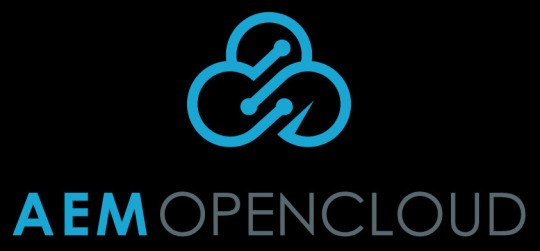
After AEM OpenCloud Full-Set Architecture in earlier part -10 we have seen how it arrange and work to deliver full functionality.
Now another variation we will see how it fit into your AEM solution for digital marketing .
Consolidated Architecture:-
A consolidated architecture is a cut-down environment where an AEM Author Primary, an AEM Publish, and an AEM Dispatcher are all running on a single Amazon EC2 instance.
This architecture is low-cost alternative suitable for development and testing environments. This architecture also offers those three types of backup, just like full-set architecture, where the backup AEM package and EBS snapshots are interchangeable between consolidated and full-set environments.
This option is useful, to restore production backup from a full-set environment to multiple development environments running consolidated architecture.
Another use case is to upgrade an AEM repository to a newer version in a development environment, which is then pushed through to testing, staging, and eventually production.
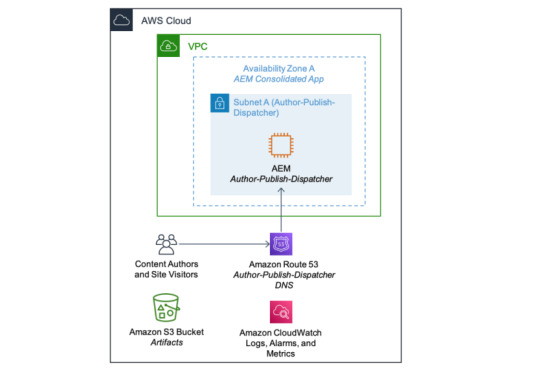
Now both require environment management full-set and consolidated architectures.
Environment Management :-
To manage multiple environments with a mixture of full-set and consolidated architectures, AEM OpenCloud has a Stack Manager that handles the command executions within AEM instances via AWS Systems Manager(described as below in picture) .

These commands include taking backups, checking environment readiness, running the AEM security checklist,enabling and disabling CRXDE and SAML, deploying multiple AEM packages configured in a descriptor, flushing AEM Dispatcher cache, and promoting the AEM Author Standby instance to Primary.
Other than the Stack Manager, there is also AEM OpenCloud Manager which currently provides Jenkins pipelines for creating and terminating AEM full-set and consolidated architectures, baking AEM Amazon Machine Images(AMIs), executing operational tasks via Stack Manager, and upgrading an AEM repository between versions, (i.e. from AEM 6.2 to 6.4, or from AEM 6.4 to 6.5)
AEM OpenCloud Stack Manager
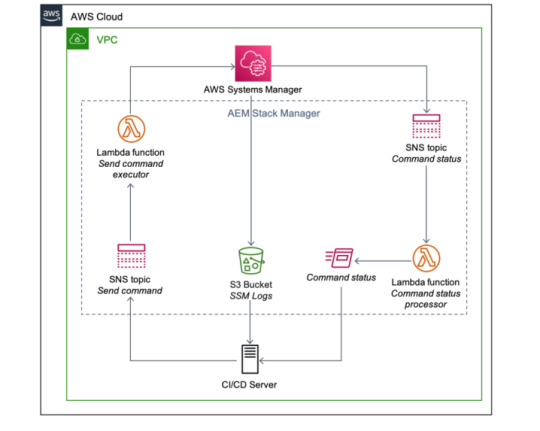
In this interesting journey we are continuously walking through AEM OpenCloud an open source variant of AEM and AWS. Few partner provide quick start for it in few clicks.So any this variation very quicker and effortless variation which gives deliver holistic, personalized experiences at scale, tailoring each moment of your digital marketing journey.
For more details on this interesting Journey you can browse back earlier parts from 1-10.
Keep reading.......
#aem#adobe#aws#wcm#aws lambda#cloud#programing#ec2#elb#security#AEM Open Cloud#migration#CURL#jenkins the librarians#ci/cd#xss#ddos attack#ddos protection#ddos#Distributed Denial of Service#Apache#cross site scripting#dispatcher#Security Checklist#mod_rewrite#mod_security#SAML#crx#publish#author
1 note
·
View note
Text
Amazon Web Service & Adobe Experience Manager:- A Journey together (Part-10)
In the previous parts (1,2,3,4,5,6,7,8 & 9) we discussed how one day digital market leader meet with the a friend AWS in the Cloud and become very popular pair. It bring a lot of gifts for the digital marketing persons. Then we started a journey into digital market leader house basement and structure, mainly repository CRX and the way its MK organized. Ways how both can live and what smaller modules they used to give architectural benefits.Also visited how they are structured together to give more on AEM eCommerce and Adobe Creative cloud .In the last part we have discussed how we can use AEM as AEM cloud open source with effortless solution to take advantage of AWS, that one is first part of the story. We will continue in this part more interesting portion in this part.
As promised in the in part 8, We started journey of AEM OpenCloud , in the earlier part we have explored few interesting facts about it .In this part as well will continue see more on AEM OpenCloud, a variant of AEM cloud it provide as open source platform for running AEM on AWS.
I hope now you ready to go with this continues journey to move AEM OpenCloud with open source benefits all in one bundled solutions.
So let set go.....................
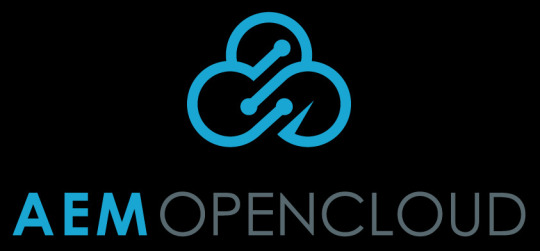
Continued....
AEM OpenCloud Full-Set Architecture
AEM OpenCloud full-set architecture is a full-featured environment, suitable for PROD and STAGE environments. It includes AEM Publish, Author-Dispatcher, and Publish-Dispatcher EC2 instances within Auto Scaling groups which (combined with an Orchestrator application) provide the capability to manage AEM capacity as the instances scale out and scale in according to the load on the Dispatcher. Orchestrator application manages AEM replication and flush agents as instances are created and terminated. This architecture also includes chaos-testing capability by using Netflix Chaos Monkey, which can be configured to randomly terminate either one of those instances within the ASG , or allow the architecture to live in production, continuously verifying that AEM OpenCloud can automatically recover from failure.
Netflix Chaos Monkey:-

Chaos Monkey is responsible for randomly terminating instances in production to ensure that engineers implement their services to be resilient to instance failures.
AEM Author Primary and Author Standby are managed separately where a failure on Author Primary instance can be mitigated by promoting an Author Standby to become the new Author Primary as soon as possible, while a new environment is being built in parallel and will take over as the new environment, replacing the one which lost its Author Primary.
Full-set architecture uses Amazon CloudFront as the CDN, sitting in front of AEM Publish-Dispatcher load balancer, providing global distribution of AEM cached content.
Full-set offers three types of content backup mechanisms: AEM package backup, live AEM repository EBS snapshots (taken when all AEM instances are up and running), and offline AEM repository EBS snapshots (taken when AEM Author and Publish are stopped). You can use any of these backups for blue-green deployment, providing the capability to replicate a complete environment, or to restore an environment from any point of time.

On the security front, this architecture provides a minimal attack surface with one public entry point to either Amazon CloudFront distribution or an AEM Publish-Dispatcher load balancer, whereas the other entry point is for AEM Author-Dispatcher load balancer.
AEM OpenCloud supports encryption using AWS KMS (Encryption Cryptography Signing - AWS Key Management Service ) keys across its AWS resources.
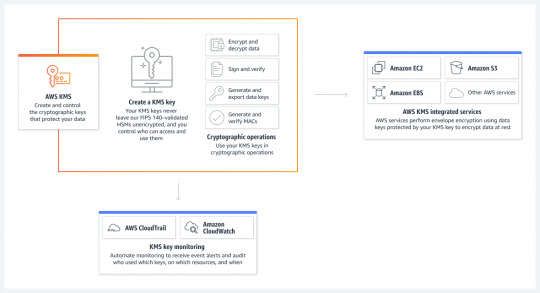
The full-set architecture also includes an Amazon CloudWatch Monitoring Dashboard (Using Amazon CloudWatch dashboards - Amazon CloudWatch) which visualizes the capacity of AEM Author-Dispatcher, Author Primary, Author Standby, Publish, and Publish-Dispatcher, along with their CPU, memory, and disk consumptions.
Amazon CloudWatch Alarms(Using Amazon CloudWatch alarms - Amazon CloudWatch) are also configured across the most important AWS resources, allowing notification mechanism via an SNS topic(Setting up Amazon SNS notifications - Amazon CloudWatch).
In this interesting journey we are continuously walking through AEM OpenCloud an open source variant of AEM and AWS. Few partner provide quick start for it in few clicks.So any this variation very quicker and effortless variation which gives deliver holistic, personalized experiences at scale, tailoring each moment of your digital marketing journey.
For more details on this interesting Journey you can browse back earlier parts from 1-9.
Keep reading.......
#aem#adobe#aws#wcm#aws lambda#cloud#programing#ec2#elb#security#AEM Open Cloud#migration#CURL#jenkins the librarians#ci/cd#xss#ddos attack#ddos protection#ddos#Distributed Denial of Service#Apache#cross site scripting#dispatcher#Security Checklist#mod_rewrite#mod_security#SAML#crx#publish#author
1 note
·
View note
Text
Amazon Web Service & Adobe Experience Manager:- A Journey together (Part-8)
In the previous parts (1,2,3,4,5,6 &7) we discussed how one day digital market leader meet with the a friend AWS in the Cloud and become very popular pair. It bring a lot of gifts for the digital marketing persons. Then we started a journey into digital market leader house basement and structure, mainly repository CRX and the way its MK organized. Ways how both can live and what smaller modules they used to give architectural benefits.Also visited how they are structured together to give more and AEM eCommerce.In the last part we have visited with Adobe Creative cloud part .
In this part as well will see more focus on movement or migration of AEM on-premise to cloud to best fit into this combination.
I hope now you ready to go with this journey to move AEM form On premise to the cloud with its best buddy AWS to enrich a lot of blessing to the digital marketing persons.
So let set go.....................
However this look like very tough and complex task but careful preparation and planning, can drive a smooth migration.
Prerequisite for the migration or pre-preparation:-
a)Archive your data.
b)Allocate sufficient time.
c)Preset the infrastructure.
Planning Before the migration:-
a)Schedule migration.
b)Freeze the content.
c)Test migrations.
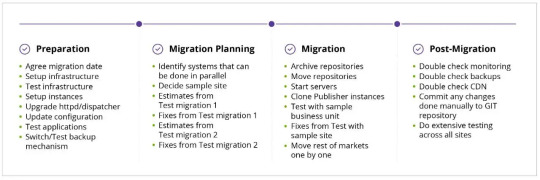
High level view of Migration Process
In case there is no CDN in front of load balancing and the switch needs to be directly on domains. Ensure that both environments are running in parallel and switch as few sites as possible one by one.
Choose a less traffic site with minimal impact and perform switch etc operation on it then start testing. If require then fix manually and then fix in the process.
Before migrating the AEM to AWS , we must know about ways. There are 2 way of the migrations:
1. Without Adobe involvement:-Directly go to AWS (Amazon Web services) and Start AEM instances from there.
2. With Adobe involvement:-But better recommended way is first go to AMS (Adobe Managed Services), and then Adobe host your AEM instances either on AWS as per your request. Here Adobe involve into complete process and manage this entire show.
1st way of migration required following decisions :-
1. Select VM’s as size, type etc.
2. Design the VPN.
3. Create the AutoScaling group(ASG).
4. Create S3 bucket for assets.
5. Create the load balancer (LB).
6. Setup Jenkins and repository.
7. Decide the CDN from cloud front or third party.
Deployment with partner or self-owned
Responsibility owned by organization for the deployment and maintenance , it required skill set of AEM, AWS and devOps as well. Or with AWS APN(AWS partner network) it can be done.
Now we will throughway in AMS(AEM Managed Service) area.
It is managed by AEM in this migration journey . Quicker, easier and more accurate in very short time span. It come with best practices and support of Adobe. Cloud Manager is main part of AEM manage service , it gives administrative features to the organization, for self-manage AEM in the cloud. It includes a continuous integration and continuous delivery (CI/CD) pipeline with performance and security.
AWS EC2 family is best suited for Author and Publish instance , as it require CPU, I/O and memory.
EC2 M5 family have some advance compute power and also provide the network and broad storage of workloads and they have good local storage too.
AEM Dispatcher is provides the additional security , caching, load balancing which require I/O, compute power and memory. Here EBS I/O optimized volume of AWS is best fit.
Adobe recommend minimum 4 core CPU with 16GB RAM

Post-Migration tasks
The CDN switch: Only when all issues are fixed, switch on the CDN side for the less traffic site, testing and rectify issue. Each CDN switch might take from 10-30 minutes to be applied, It is alwayse better to switch in phases at least 3-5 phases.
Load Balancer:- As we know why we are using the load balancer i.e to distribute the traffic.
Classic Load Balancer versus ALB
Switching from a Classic Load Balancer to an Application Load Balancer (ALB) is highly advised as it enables a lot of possibilities.
For example, one ALB can hold multiple certificates, so you can support multiple domains. An ALB can also have different target groups based on the hostname, which allows you to use the same load balancer to handle multiple interactions. For example, 80/443 ports are open for web access and some other ports are open for deployments of target groups based on the hostname.
The Application Load Balancer has deletion protection and, in the case of debugging, you can do a request tracking.
Scaling:- In order to overcome CPU/EC2 is failing then we can configure the auto scaling so whenever when there is health issues on the EC2 it will create the new EC2/CPU and redirect the traffic over there.
Content delivery:- This is used for caching layer in AWS we use cloudFront but you can use 3rd party (CDN).
Dynamic Content:- To incorporate dynamic elements in a static page, the recommended approach is to use client-side JavaScript, Edge Side Includes (ESIs), or web server level Server Side Includes (SSIs). Within an AWS environment, ESIs can be configured using a solution such as Varnish, replacing the dispatcher.
S3 :- It is used to store the binary data and back up management related stuff.
Tools to simplify the migration process and management
Apply server: Using the apply server, you can enable your setup to be much more automated. In some cases, you might not have the luxury of using a fully-fledged configuration management system like Puppet or Chef, and there may be a need for something more flexible with regards to releases and deployments. With the apply server, you don't need that flexibility. It is a tiny tool that can be put into place and whose specific actions you can control. This makes use of HTTP/S and no longer requires SSH access.
Shell2http: Shell2http is a tool that allows you to configure specific commands on a specific host. In practice, we use it to allow people to clear the cache on host machines via URL without giving them access to the machine console. This allows us to configure additional terminal commands that can be used on the machine if necessary.
Puppet (configuration management): We utilize Puppet as our main configuration management tool across our projects. Puppet has a repository in Git that is split depending on the project; based on the machine hostname it detects the environment and role.
Git (version control): Git is our main distributed version control system, which we utilize for maintaining application configuration files and application code within it. We utilize Jenkins to build application packages (that are maintained by Puppet on the machines), which also includes application configuration files.
Jenkins (ci/cd): As Puppet maintains only machine configuration files, the packages built by Jenkins have application configuration files included in them as well. The application configuration files are split by environments and roles to ensure we apply the correct configuration to the correct machine.
Nexus (software repository): Developers upload created packages for deployment to Nexus, the package repository manager. Jenkins then takes the package or packages from Nexus and uploads them to a target machine where it triggers their installation.
Terraform: It enables users to define and provision a datacenter infrastructure using a high-level configuration language known as Hashicorp Configuration Language, or optionally JSON.
Here after this migration , Cloud benefits and feature can leverage but it require a lot of effort and phase. It require handle concerns as well. But there is another player in the market which can make our life easier.
So welcome our new champ in this area AEM OpenCloud.
A very brief intro about AEM OpenCloud(we will see in detail in the coming parts)
It include AEM publish dispatcher , author dispatcher, publisher EC2 instance with auto scaling group which will scale out and in according to the traffic on the dispatcher. Also include the testing capability.
AEM openCloud helps to handle the command execution within the AEM. This include the taking backups, disabling and enabling the crx/de , SAML, deploying the multiple AEM package , AEM security checklist etc. Helps in upgrading the repository.
Security of AEM and AWS :-
Infrastructure level Security:-AWS provide the several services for the security to secure the infrastructure.
Application level Security:- AEM security checklist with the dispatcher security checklist. Mainly security aspect right from the AEM in production mode to using mod_rewrite and mod_security modules from Apache to prevent Distributed Denial of Service (DDoS) attacks and cross site scripting (XSS) attacks.
Automated Deployment :-
AWS provides API access to all AWS services, Many of the various commands to deploy code or content, or to create backups, etc. For CI/CD process with the use of Jenkins as a central hub, invoking AEM functionality through CURL or similar commands.
In this journey we walk through AEM & AWS migration and AEM Open Cloud. So any this combination deliver holistic, personalized experiences at scale, tailoring each moment of your digital marketing journey.
For more details on this interesting Journey you can browse back earlier parts from 1-7.
#aem#adobe#aws#wcm#aws lambda#cloud#programing#ec2#elb#security#AEM Open Cloud#migration#CURL#jenkins the librarians#ci/cd#xss#ddos attack#ddos protection#ddos#Distributed Denial of Service#Apache#cross site scripting#dispatcher#Security Checklist#mod_rewrite#mod_security#SAML#crx#publish#author
1 note
·
View note
Text
Amazon Web Service & Adobe Experience Manager:- A Journey together (Part-5)
In the previous parts (1,2,3 & 4) we discussed how one day digital market leader meet with the a friend AWS in the Cloud and become very popular pair. It bring a lot of gifts for the digital marketing persons. Then we started a journey into digital market leader house basement and structure, mainly repository CRX and the way its MK organized. Ways how both can live and what smaller modules they used to give architectural benefits.Also visited how the are structured together to give more.
In this part as well will see on the more in architectural side.
AEM scale in the cloud
A dynamic architecture with a variable number of AEM images is required to fulfill the operational business needs.
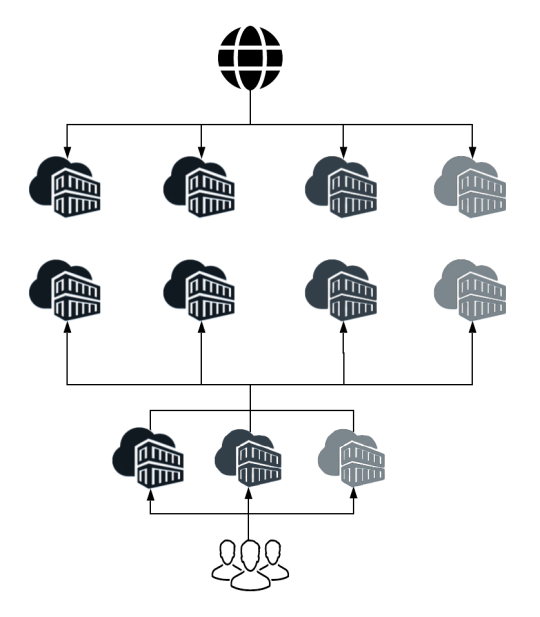
AEM as a Cloud Service is based on the use of an orchestration engine.Dynamically scales each of the service instances as per the actual needs; both scaling up or down as appropriate.
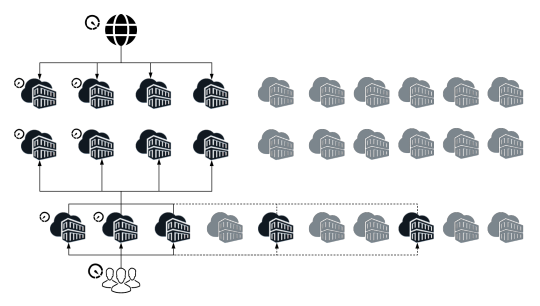
Scaling is a very simple task in AWS with creating separate Amazon Machine Images(AMIs) for publish , publish-dispatcher and author- dispatcher instance.
Use an AMI
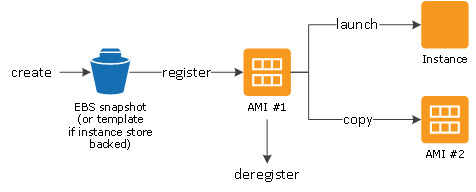
Three separate launch configurations can be created using these AMIs and included in separate Auto Scaling groups(Auto Scaling groups - Amazon EC2 Auto Scaling).
AWS Lambda can provide scaling logic for scale up/down events from Auto Scaling groups.
Scaling logic consists of pairing/unpairing the newly launched dispatcher instance to an available publish instance or vice versa, updating the replication agent (reverse replication, if applicable) between the newly launched publish and author, and updating AEM content health check alarms.
One more approach for the quicker startup and synchronization, AEM installation can place on a separate EBS volume. A frequent snapshots of the volume and attachment to the newly-launched instances, Cut-down need of replicate large amounts of author data. Also it ensure the latest content.
CDN:-Content Delivery Network or Content Distribution Network
A CDN is a group of geographically distributed and interconnected servers. They provide cached internet content from a network location closest to a user to speed up its delivery.
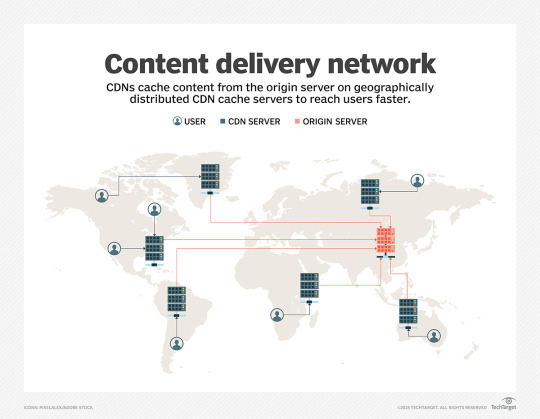
AWS is having answer of CDN requirement as well in the form of Amazon CloudFront a Low-Latency Content Delivery Network (CDN)
How it works
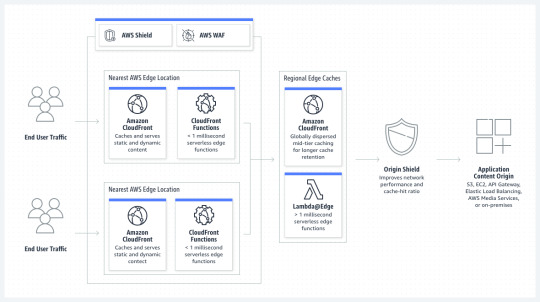
It will act as an additional caching layer with AEM dispatcher. Also it require proper content invalidation when it refreshed.
Explicit configuration of duration of particular resources are held in the CloudFront cache, expiration and cache-control headers sent by dispatcher required to control caching into CloudFront .
Cache control headers controlled by using mod_expires Apache Module.
Another approach will be API-based invalidation a custom invalidation workflow and set up an AEM Replication Agent that will use your own ContentBuilder and TransportHandler to invalidate the Amazon CloudFront cache using API.
These all about caching of static content only what is the solution or way to handle Dynamic content will see now.
Content which is Dynamic in Nature
Dispatcher is the key element of caching layer with the AEM. But it will not give full benefit when complete page is not cacheable. Now the question arise how dynamic content can fit into page without breaking the caching feature. There are some standard suggestion available. Like Edge Side Includes (ESIs),client-side JavaScript or Server Side Includes (SSIs) incorporate dynamic elements in a static page.
AWS is also have one solution as Varnish(replacing the dispatcher) to handle ESIs . But its not recommended by Adobe.
Till here we have seen structure of content dynamic static and various ways, but digital solution also have huge number of Assets mainly binary data. These need to configure handle properly to ensure performance of the site.
Again AWS is equipped with great solution called Amazon S3.
AEM Data Store with Amazon S3
Adobe Experience Manager (AEM), binary data can be stored independently from the content nodes. The binary data is stored in a data store, whereas content nodes are stored in a node store.
Both data stores and node stores can be configured using OSGi configuration. Each OSGi configuration is referenced using a persistent identifier (PID).
AEM can be configured to store data in Amazon’s Simple Storage Service (S3), with following PID for configuration
org.apache.jackrabbit.oak.plugins.blob.datastore.S3DataStore.config
To enable the S3 data store functionality, a feature pack containing the S3 Datastore Connector must be downloaded and installed. For more detail please refer Configuring node stores and data stores in AEM 6 | Adobe Experience Manager
This will simplifying management and backups. Also, sharing of binary data store across author and between author & publish instances will be possible and easier task with AWS S3 solution. it will reduce overall storage and data transfer requirements.
Already this great combination walkthroug of the structure combination posibbilities , we will see one more variation available for the Cloud version of AEM with AWS in next (AEM OpenCloud)
Thanks for being with me till this , we will meet in next part with some amazing journey of OpenClode.
Hope you enjoy most till this part, kindly keep your blessings and love to motivate me.
Continue............
#aem#aws#adobe#cloud#wcm#programing#ELB#Amzon S3#OpenClode#OSGi#SSIs#ESI#CloudFront#Datastore#connector#Dispatcher#API#ContentBuilder#TransportHandler#CDN#AWS Lambda#aws lambda#Amazon EC2 Auto Scaling#ASG Auto Scaling Group#Amazon Machine Images(AMIs)#AEM AUTHOR#AEM Publish
1 note
·
View note
Text
Amazon Web Service & Adobe Experience Manager:- A Journey together (Part-4)
In the previous part (1,2 &3) we discussed how one day digital market leader meet with the a friend AWS in the Cloud and become very popular pair. It bring a lot of gifts they bring for the digital marketing persons. Then we started a journey into digital market leader house basement and structure, mainly repository CRX and the way its MK organized. Ways how both can live and what smaller modules they used to give architectural benefits.
Now will see more on the lower level how the are arrange and manage benefits in the digital marketing area.
More on architectural sizing we will see how the AEM main area like dispatcher etc are organized into the big picture.
Dispatcher is the key family member who is taking care of Performance like matter with content caching and most important matter of load balancing.Also handling some application security aspect.
AEM dispatcher is the primary based on the Apache HTTP web-server modules and installed on the Amazon EC2 instance.
Amazon Elastic Block Store (Amazon EBS)*** I/O optimized volumes is the first choice for AEM dispatcher as it require optimized I/O operation and require memory and computation capabilities.Mapping of dispatcher instance is oneto-one with publish instance in each availability zone.
Availability zone 1:-
AEM dispa11--->publish11
AEM dispa12--->publish12 ------ so on
Availability zone 2
AEM dispa21--->publish21
AEM dispa22--->publish22 ------ so on
***Amazon Elastic Block Store (Amazon EBS) is an easy-to-use, scalable, high-performance block-storage service designed for Amazon Elastic Compute Cloud (Amazon EC2).
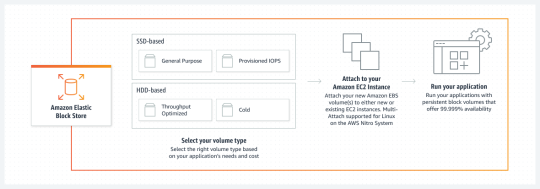
Availability zone 1:-
AEM dispa11--->publish11
AEM dispa12--->publish12 ------ so on
Availability zone 2
AEM dispa21--->publish21
AEM dispa22--->publish22 ------ so on
AEM installation on EBS volumes , two options are available either General Purpose SSD (GP2) volumes or provisioned Input/Output operations Per Second (IOPS) volumes. It provided a specific level of performance and lower latency.
AEM H/W sizing requirement
1)Intel Xeon or AMD Opteron CPU with at least 4 cores
2) 16GB RAM
According to the above hardware sizing, it can best fit into Amazon's EC2 M5.XL instance type. Start with EC2 M5.2XL and as per future workload it can be increased or decreased.
H/W Sizing Recommendations depends on the bellow factors
Network speed
Network latency
Available bandwidth
Computational speed
Caching efficiency
Expected traffic
Complexity of templates, applications and components
Concurrent authors
Complexity of the authoring operation
I/O performance
Performance and efficiency of the file or database storage
Hard Drive
at least two or three times larger than the repository size
Memory
Size of website
Number of concurrent users/sessions
###For more detail got to Hardware Sizing Guidelines | Adobe Experience Manager
Requirement of AEM servers depends uses experience management or DAM digital asset management.
A Minimal setup require five servers for high availability configuration in two Availability Zones and each zone have one pair of dispatcher-publisher and a single author node in any one zone.
2 availability zone--> 2*one pair of dispatcher-publisher--> total 4 server-->plus one for author in any zone--> now in total 5 server required for this minimal setup.
Load Balancing beyond dispatcher
Dispatcher is an internal AEM load balance but from the proper traffic management to handle peak hour traffic external load balancer is required AWS provide various load balance here ELB (Amazon Elastic Load Balancer - AWS) is best fit to control traffic to the dispatcher.
ELB load balancer distributes incoming requests evenly across AZs(availability zones). Also incoming requests can be evenly distributed to all servers regardless of AZs , enable cross-zone load balancing.
Load Balancer for sticky sessions: Authentication is the way to recognize the user with login mechanism,authentication is maintained by a login token.Token information stored under tokens node of the corresponding user node in repository(session id ). In the browser it stored as cookie i.e. login-token.
Here LB(load balancer need to configure for the sticky sessions , so user who authenticated on the server routed accordingly on appropriate server.
sticky sessions-->routing requests --with the--> login-token cookie -->same instance of authentication.
AEM can be configured to recognize the authentication cookie across all publish instances. However, it also requires that all relevant user session information (for example, a shopping cart) is available across all publish instances.
ELB --> in front of the dispatchers to provide a Single CNAME URL for the application.
LB with AWS Certificate Manager, for HTTPS access and to offload.
For security LB is also contributing by moving the publisher instances into a private subnet, which can access only via LB.
LB can translate port as well like default port of web is 80, so all request come to port 80 but AEM publish port is 4503 . LB can translate internally 80 into 4503.
Ensuring High Availability with this superb pair of AWS - AEM
HA (High Availability) is the process to eliminate single points of failure ,ensure continuous operation of digital marketing. The primary goal of HA is to ensure system uptime even in the event of a failure. Some time its referred as Five-nines(99.999%) availability.
Here is we are taking about the HA and five-nines or eliminating single points of failure then it will increase h/w redundancy to create backup systems.
Again the great buddy AWS of AEM from this pair will come as savior and make all the arrangement silently without more noise.
AWS provide strengths to the structure with its recovery feature. Configure each instance in the AEM cluster for Amazon EC2 Auto Recovery(Recover your instance - Amazon Elastic Compute Cloud).
Availability leads recovery as well as handling load or switching in case of failure to correct node.For this the cluster is built in conjunction with a load balancer i.e. AWS Auto Scaling to automatically provision nodes across multiple Availability Zones.

Provisioning of nodes across multiple Availability Zones for high availability is recommended, and multiple AWS Regions is answer to global deployment. AWS provides Amazon Route 53 to perform DNS fail-over for multi-Region deployment, based on health checks.
Continue in next part about more on this journey of both great buddy in software and digital marketing........
#aem#adobe#wcm#aws#programing#EC2#ALB#security#load balancer#HTTPS#SSL#CNAME#Sticky session#Token#authentication#ELB#intel#atom
1 note
·
View note
Text
Cache Experience Fragments in AEM Using Sling Dynamic Include
Cache all the experience fragments in AEM under a common or shared location on the dispatcher to load dynamically whenever the XF page is activated. Improve initial page load performance on subsequent requests on the same or similar pages.
Problem Statement: Cache all the experience fragments in AEM under a common or shared location on the dispatcher to load dynamically whenever the XF page is activated. Improve initial page load performance on subsequent requests on the same or similar pages. Introduction: The purpose of the module presented here is to replace dynamically generated components (eg. current time or foreign…
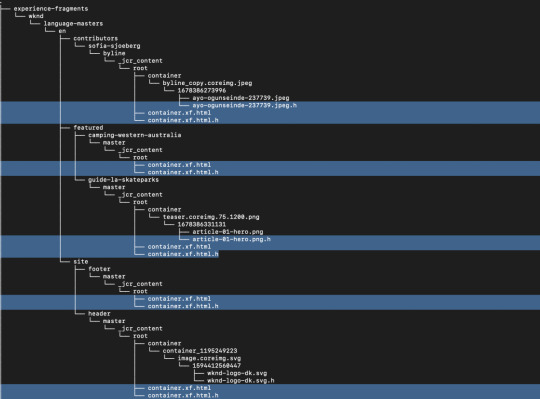
View On WordPress
#AEM#AEM as a Cloud Service#aemaacs#Best practices#Common#Experience Fragments#SDI#Shared#Sling Dynamic Include#XF
0 notes
Text
AEM Architect AD0-E117 Exam Questions
Are you ready to pass your AD0-117 Adobe Experience Manager Sites Architect Master exam? PassQuestion provides the most up-to-date AEM Architect AD0-E117 Exam Questions that you can use to prepare for the exam.After using PassQuestion AEM Architect AD0-E117 Exam Questions mutile times, you can get your Adobe Certified Master - AEM Architect certification easily. It is highly recommended to go through all of our AEM Architect AD0-E117 Exam Questions so you can achieve the best results and clear the Adobe AD0-E117 exam on the first attempt.
Adobe Experience Manager Sites Architect Master(AD0-E117)
The Adobe Certified Master - AEM Architect certification is the industry-recognized validation of one's proficiency in Adobe Experience Manager. This certification requires in-depth knowledge of integrating AEM into application servers and web servers, designing a solution architecture, and creating migration solutions.
At a minimum, the candidate seeking to become certified as an AEM Architect at least 3 years of experience architecting AEM Sites. The AEM Architect is responsible for designing technical aspects of the AEM platform and optimally leveraging the product features.
NOTE: This exam covers AEM 6.4, 6.5, and AEM as a Cloud Service.
Exam Information
Exam number: AD0-E117 Exam name: Adobe Experience Manager Certificate level: Certified Master Status: Active Available languages: English Number of questions: 50 Formats: Multiple choice and multiple select Duration: 100 minutes Delivery: Online proctored (requires camera access) or test center proctored Passing mark: 58% or 29/50 [Please note: Percentage score would only be seen on older exam scores.] Price: $225 USD / $150 USD (India)
Exam Objectives and ScopeSection 1: Discovery (18%)
Translate high-level business goals to functional requirements
Given a scenario, assess the current state of an architecture
Determine non-functional technical requirements for solution design
Section 2: Solution Design (44%)
Given business requirements, design detailed architecture and solution
Given a scenario, determine appropriate security solutions for a design
Apply procedural concepts to incorporate integration requirements into a solution design
Determine which types of performance and testing requirements should be included in a solution
Apply procedural concepts for designing scalable and resilient architecture
Given a scenario, recommend migration strategies
Section 3: Implementation (22%)
Given a scenario, identify and resolve design issues revealed during implementation stage
Given a scenario, recommend implementation approaches based on requirements
Determine appropriate methods to use to prototype solutions for proof of concepts
Given a scenario, diagnose and resolve issues encountered during implementation
Section 4: Maintenance (16%)
Given a scenario, diagnose and resolve issues encountered in production environment
Apply procedural concepts to plan for use of new features and upgrades
Given a scenario, optimize solution for non-functional requirements
View Online Adobe Experience Manager Sites Architect Master AD0-E117 Free Questions
A client has an existing AEM site using components that proxy AEM WCM Core Components. The site uses simple page authoring without referenced content, The client wants to create a new experience on another marketing channel. The plan is to use as much of the existing page content as possible to avoid refactoring the current content and to maintain consistency across channels. Which AEM capability should an Architect use to meet these requirements? A.Experience Fragments B.Content Fragments C.Assets API D.Sling Model Exporter Answer : B
An AEM Architect is moving existing content from an on-premise AEM to an AEM Cloud Service instance using the Content Transfer Tool. As part of the initial source preparation, the Architect is going to run the offline compaction on the on-premise AEM. What other two actions should the Architect do to the on-premise AEM before proceeding with the extraction phase? (Choose two.) A.Validate that all replication agents are disabled B.Verify that wipe mode is enabled C.Stop all bundles using the AEM Web Console D.Verify that free disk space is at least 1.5x the JCR size E.Run datastore consistency check via oak-run Answer : B, D
An existing AEM sites platform will receive the latest service pack. The service pack includes functional and non-functional fixes such as security patches. Which action should the Architect take to make sure the update is successful? A.Advise the customer to request Adobe to install the fixes directly on production since they are prechecked. B.Install the service pack m staging and ensure that all the bundles are up and running, then deploy to production. C.Identify the packages affected by the service pack after installing them into production and monitor them. D.Do a full staging of the service pack including a regression test, if passed, deploy to production. Answer : C
During development the AEM Publisher server keeps crashing randomly. The deployment included a new static FAQ component that was used in the websites Contact Us page. An Architect investigates to find the root cause for the random failures, and notices the following parameters: * The server slows down when requests are sent to the Contact us page * The number of requests to the page were very few * Heap dump shows a large number of instances of the FAQ component What is likely causing this issue? A.The page was not cached in the Dispatcher. B.The component triggers a traversal query. C.The JVM garbage collection is not running. D.The component has a cyclic dependency to itself Answer : D
A client using AEM 6.5 on-premise is experiencing an unsustainable repository growth of 100Gb a day. After investigation, an Architect finds out that the DAM is causing this issue. Each image uploaded to the DAM triggers the creation of approximately 100 renditions, necessary by business to consume in different channels and systems. The client also complains about stale content reported by site visitors happening randomly in pages where article-related components are present. How should the Architect address these issues? A.Leverage AEM Adaptive Image Servlet, cache image variations in Dispatcher, and reimplement article-related components to use AJAX to load the content B.Split WCM and DAM in separate instances, set up Connected Assets, and re-implement article-related components to use AJAX to load the content C.Leverage AEM Adaptive Image Servlet cache image variations in Dispatcher, and implement a cache TTL in Dispatcher D.Split WCM and DAM in separate instances, set up Connected Assets, and implement a workflow to purge all pages affected by an article change in Dispatcher Answer : B
0 notes